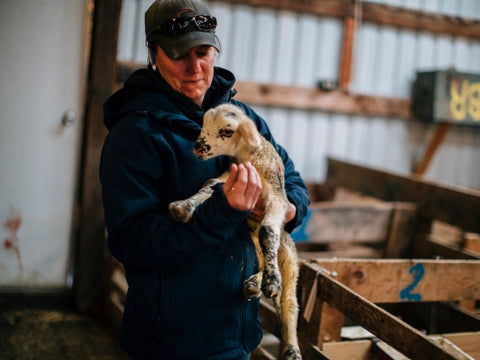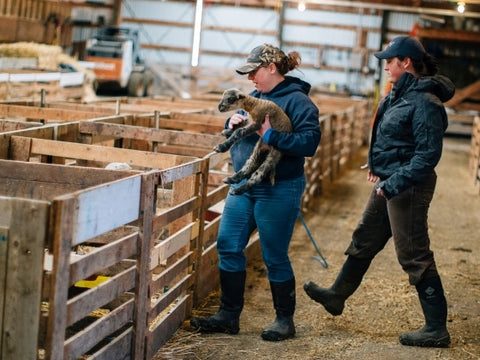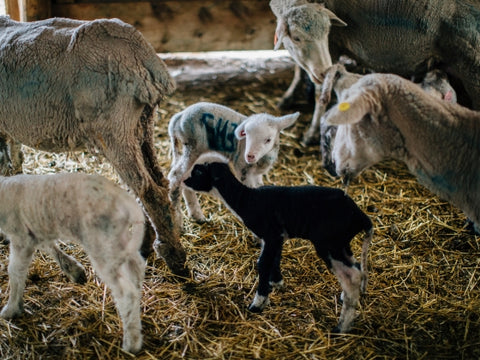Lambing season full of surprises
Montana lambing season



Students learn lambing process at 10,000-acre ranch
By Jenny Lavey
BOZEMAN – It’s the last week of April and the snow has finally stopped at Montana State University’s Red Bluff Ranch, 36 miles west of Bozeman just off Norris Road. Farm-truck mud rivets run deep and the only sound is the Madison River Valley’s late-spring wind that still carries winter’s bite. At every turn, the ranch’s budding green hills are peppered white with new lambs hobbling on rickety legs. “We can finally say the “Q” word this week,” said Arianne Perlinski, attending veterinary technician and farm assistant with the Montana Agricultural Experiment Station.

“It’s finally quiet. Last week, it was all hands on deck –there wasn’t even time to really check the clock. We had between 70 to 80 lambs born per day.” If there’s a harbinger of spring at MSU, it’s likely the sight of MSU’s sheep flock showing signs of early labor, commencing the annual MSU lambing season.
While students prepped for final examinations on campus, Perlinski and her team of 15 temporary employees, 11 of whom are students, were busy on the ranch assuring the safe and healthy delivery of 926 lambs from 675 ewes representing the Targhee, Rambouillet and Columbia breeds. The ranch sprawls 10,800 acres, most of it rangeland, and is home to cattle and sheep year-round that are used in variety of research and teaching involving grazing, breeding and animal health. The ranch’s lambing season, according to Perlinski, lasts about the entire month of April and often extends into early May.
“At peak time, it’s a muddy, windy, chaotic symphony,” Perlinski said. “Some days it’s exhausting, but then you realize the weight of the responsibility for these animals and it becomes a very special job. There’s not a day I don’t drive home recounting the day with these animals.” At the center of the season, Perlinski said, is the opportunity for students to apply animal science coursework to a real-life ranching situation, where Mother Nature dictates the flock’s vulnerability to weather, unpredicted labor complications, hungry predators and risk of infection – all of which can escalate in a moment.

Perlinski said students participate in every stage of lambing, from health-checking for signs of early labor, to the actual delivery and postpartum care of ewes and lambs. Katie Combs, a senior from Utica, New York, majoring in animal science in the Department of Animal and Range Sciences in the College of Agriculture, said the opportunity to participate in lambing provided her a deeper understanding of livestock birth. “I’d had experience calving with dairy cattle, but not sheep, so it was a whole different animal and learning process for me,” she said. “Learning and becoming confident about signs, challenges and getting the hang of it was invaluable experience. It’s something I’m sorry I waited to join in on until I was a senior; some of the material in class would have made a lot more sense.”

Lambs wander into pens on Wednesday, April 26, 2017, at Montana State University's Red Bluff Research Ranch near Norris, Montana. Lambing season, typically the entire month of April, helps students in animal range science receive first-hand experience in a working ranch. MSU Photo by Adrian Sanchez-Gonzalez
Just after birth, students are charged with marking the ewe with a number that matches her lamb. More than 50 percent of the lambs born are twin sets, Combs said, so the tagging is critical for record keeping and keeping pairs together. “I feel like I have a better understanding of the animal’s behavior from interacting and observing them over the season,” Combs added. “There (are) just some things you wouldn’t pick up or appreciate as much from classroom instruction only.”
Perlinski says she tries to mirror the in-class animal reproductive curriculum as much as possible, but also teaches lambing students to focus on a low-stress labor and delivery approach, with as little human interference as possible. Some of the more challenging situations students may encounter include difficult labors, where the lamb is in the breech position during delivery and students must intervene to deliver the lamb as safely as possible, Perlinksi said.
Other challenges during the season include natural preterm miscarriages malnourishment, the weather, birth deformities, uterine infections and vaginal prolapse in ewes. “Just like any other working ranch, there’s a range of what can happen when it comes to animal health,” said Raven Phifer, a junior from Camden, Tennessee, majoring in equine science in the Department of Animal and Range Sciences.“It’s always challenging when to know to let things happen naturally and when to step in and help, but I’ve learned most from making diagnostics on the land, in the elements, when things are happening.
That’s when I’m able to put it all together.” Phifer said it’s particularly challenging to watch a ewe reject her lamb, which is common among sheep.
“First-time breeders often will neglect the lamb, and that’s where (we) try to intervene so that the baby can get colostrum during the first 24 hours, which is a critical time period,” she said. “Wiping some of the amniotic fluid on the mom’s nose so that she can smell her pheromones and naturally want to nurse her lamb is an example of helping maternal instincts kick in without much meddling.”
Perlinksi said staff will bottle feed a lamb if a ewe rejects it, and the ranch will sell the lambs and ewes to 4-H participants, local ranchers and hobby farms. “We’re a working ranch and our flock is mostly used for education and research, but we do care for the animals like any other livestock operation,” she said. “We want them to go to good homes and be of value for grazing, processing or for a local 4-H’er.”
A lambing instructor in the College of Agriculture at Montana State University, carries a lamb on Wednesday, April 26, 2017, at MSU Red Bluff Research Ranch near Norris, Mont. Lambing season, typically the entire month of April, helps students in animal range science receive first-hand experience in a working ranch. MSU Photo by Adrian Sanchez-Gonzalez




Leave a comment